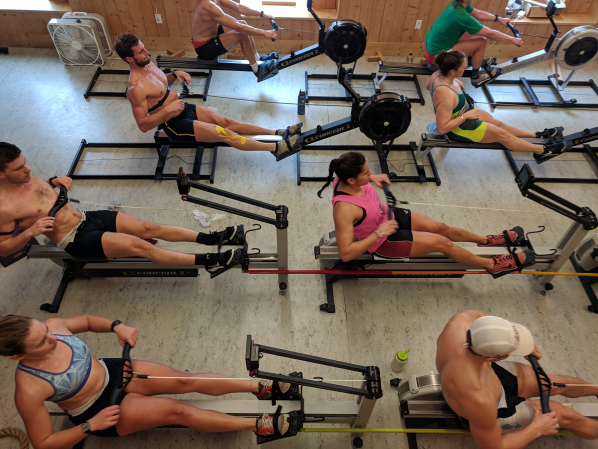Rowing Dynamically: Slides vs. the Dynamic RowErg

Scullers and sweep athletes who are looking to get more out of the indoor season can benefit from dynamic training. Concept2 offers two options for this: Slides and the Dynamic RowErg. How do they compare?
We describe these types of training as “dynamic” because they better simulate the dynamics of rowing a boat on the water, where the rower is heavier than the boat, so the boat moves around the rower's mass. Off-water, this same feel is simulated by having the erg move around the rower's mass, which is mostly stationary. The dynamics of how the mass of the machine and athlete move, therefore, are a bit different even though the same rowing stroke is used. The same stroke sequence, power application and technique are used no matter what machine you’re on.
Slides
Slides are a popular option because they are an easy way to convert your fixed erg into a dynamic erg. If you already row on a Model A, B, C, D or E, you can place it on a set of Slides (no tools required) to “float” your machine. On Slides, the RowErg will move back and forth beneath you on every stroke. If you're rowing well, the Slides feel smooth and rhythmic. If you row at inconsistent stroke rates, drive lengths or power applications, the Model D will crash and bang along the Slides—clear feedback that your technique needs improvement.
Slides require a large footprint of 11 feet for use. The space recommended to row on the Models D and E, in comparison, is only 9 feet. Stationary RowErgs are still the standard for athletes testing on teams and in clubs. Slides provide a flexible way to experience dynamic training, which gives better feedback on nuances of the stroke.
The Dynamic RowErg
The Dynamic RowErg is designed to react to athletes' movements in a way that is similar to rowing on the water in a lightweight rowing shell. Because both the handle and footstretchers are moving, the catch requires careful coordination of the arms and legs at the same time. If the handle and feet don't engage together, the stroke will feel syncopated and short. Just as the legs begin the drive, the arms, core and shoulders need to be stable and powerful, just like on the water.
In addition, there is less return force on the handle on the Dynamic than on the Model D. This means there is less assistance on the recovery, so as in a boat, you are fully responsible for pressing the handle away, setting a forward body lean, and moving up the slide to full compression.
While the Dynamic has yet to become the standard for athlete testing, it can be a valuable training resource. The Dynamic is compact in size but also requires a dedicated training space in a boathouse or home. (It cannot separate for storage.)
Team Training
Team training is possible with both Slides and the Dynamic. Connecting ergs allows you to create boats of any size and practice stroke coordination. On Slides, the total length needed for set up is calculated by: (the number of indoor rowers x 8.5 feet) + 3.5 feet. You'll need an additional Slide for each additional erg you wish to connect. Athletes can feel their connection from the movement of the machines beneath them.
Dynamics can be connected with a Link that is installed on the foot carriage. Athletes feel the coordination of their drive directly through the footrests. Brackets stay installed on the Dynamic so that the Link can be easily added or removed. The compact length makes it easier to build bigger “boats.” The space required for team training can be calculated by: number of machines x 7 feet.
Finding Speed
On both the Slides and the Dynamic, it may feel easier to row at high stroke rates, since you aren't moving the mass of your body as much. Greater energy is required to maintain high stroke rates, however, so it is always difficult to predict how this will affect your results. World Records and Rankings for rows on Slides and the Dynamic are maintained separately. There is not a clear competitive advantage to rowing dynamically reflected in these results.
Which Should I Use?
Dynamic training adds value to your rowing: it loads your muscles differently throughout the stroke, challenging you to react with strong technique. If you already own a Model C, D or E, the Slide is an affordable and flexible way to try dynamic rowing.
The Dynamic RowErg commits you to rowing dynamically all the time. The feel is a bit more refined: the mass of the footrest feels more like rowing a single than the weight of the Model D (57 lb). The high-strength cord adds a lightweight feel to the stroke. The Dynamic is a great tool to increase speed on water and is recommended for athletes and teams that are dedicated to this type of training.
